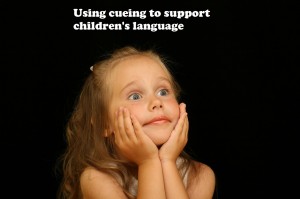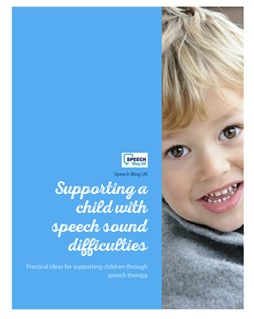A few weeks ago, Elizabeth posted about different ways that speech therapists use cueing to help children with speech sound difficulties. We can also use cues to support children with comprehension and expressive language difficulties as well. We thought it would be useful to share some of these here too. As I planned this post, I realised what a huge topic this is – this will be very much a whistlestop tour today – do share other ideas in the comments.
Tactile
Signing is a really useful way of supporting children’s language. This may not seem like an obvious thing to do with children who have some verbal language, but it can be so useful for so many reasons. Here’s my post on why signing is useful. With children with language difficulties, we always speak as well as signing as the intention is to use the signing to enhance their verbal language not instead of speaking. Here are two ideas of how I use signing to cue children (there are many more):-
- I often sign just a few words when I am speaking to draw a child’s attention to them and help them to understand. For example, I might sign the question word (who, what, where etc) as these are words that children are frequently confused by and the signs help them to know which piece of information I am asking for. Then I gradually withdraw the sign prompt as the child becomes better able to understand the question.
- I often use signing to support children with using longer sentences. I work with one child with learning difficulties who usually uses just 1-3 word phrases. However, if I sign to her to remind her of which words to put in, she can use a sentence with 5-6 words in. I started by signing every word and then gradually withdrew the signs until now I just sign when she gets stuck. This has really helped her to expand her sentences.
Visual
First of all, I often use visual cues to help children to give eye contact and maintain their attention level. This in itself can help so much with understanding! In a 1:1 session, I work to get eye contact, which often means moving my own position to make it easier for them. I also often pick up pictures we are looking at or a toy that we are using. I pause for a moment and when the child is watching it, move it up to my face to encourage them to look.
I also use lots of visual methods to directly support children’s understanding. There are so many of these that I don’t think I can do much more than list them today, but there are many topics here to return to another day. Here are some ideas of visual support methods:-
- Visual timetables – these are used to help children who struggle with change. Basically you put up a strip of pictures of each thing that will happen over a certain period of time (sometimes a whole day, sometimes less). Then when each item is finished, encourage the child to take the picture off and put it into a pot so they can see the structure of the day and know what is coming up and when they will get to do their favourite activity (which should hopefully be on there somewhere! For more information about visual timetables read this post.
- PECS – I’m not even going to try to describe this in a few words – check out this link to find out more!
- Mind maps
- Vocabulary pictures
- Story maps – these help students to structure and plan stories. You can find great story maps in the Black Sheep narrative packs.
- Visual methods to support sentence structure are also available and can help so much for children who muddle word order. The idea of these is to use colour and/or shape to help children to see the pattern of how the sentence should work. There are two main systems that I know of (Shape Coding and Colourful Semantics) which can help so much with both spoken and written language.
Verbal
There are also lots of verbal methods of cueing. When a child struggles to find a word or to answer the question they’ve been asked, here are some of the ways I try to help without actually telling them the answer.
- Repeating or rephrasing a question.
- Offering a verbal choice. This is one of those terms speech therapists use which I don’t think mean much to other people! Let me give you an example of what I mean. Let’s imagine I’ve asked a child “what is this person doing?” while we’re looking at a picture or book. The child doesn’t respond or says “pencil”. I try asking again – “yes, that’s right it’s a pencil. What’s he doing with the pencil?” If they still struggle I might offer a choice “is he running or drawing?” This is better than just telling the child the answer and asking them to repeat, as they’ve successfully answered the question (which builds confidence and self-esteem) and they’ve still had to think about and pick the answer from two options. One small word of caution with this – try to sometimes put the correct answer first – some children just repeat the last thing they heard and so can look like they are understanding more than they are.
- Giving clues to a word. This helps particularly with children with word-finding difficulties. It does rely on you knowing the word they are looking for! There are two types of clues you might give. Firstly, you might give phonological cues (information about what a word sounds like – for example, I might say the first sound – “l”, or the number of syllables – “2 syllables” or “2 claps” or other information relating to the sound). Alternatively, you could give semantic clues (these are clues relating to the meaning of the word eg “it roars”, or “it’s like a tiger it’s a…”). Giving these sorts of clues help children to access the word from different information within their lexicon (internal word store) which helps them not only to find the word this time but also to find it more easily next time. There are more ideas about how to help with word-finding here.
There are many other ways that we cue children to help them use language for themselves rather than being told the answers. One final thought – If the child is unable to respond even after some of these prompts, do also remember to consider that you may have have asked a question that’s too difficult to begin with! We can all do from time to time!
What other ways have you found successful for supporting children’s comprehension and/or expressive language?







Leave a Reply